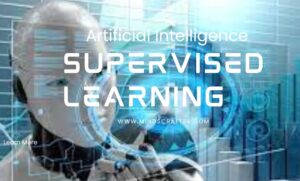
AI Supervised Learning
Mastering the Basics of Supervised Learning:
Supervised learning is one of the most popular and fundamental techniques in machine learning. It involves training a model using labelled data to predict new, unseen data outcomes. If you’re new to machine learning, the concept of supervised learning can seem daunting. However, mastering the basics of supervised learning is crucial if you want to build robust and accurate models. This article will break down the fundamentals of supervised learning step-by-step, starting with what supervised learning is and how it differs from other types of machine learning. It will also cover how to prepare your data for training, select the appropriate algorithm, and evaluate your model’s performance. By the end of this article, you’ll have a solid foundation in supervised learning that will enable you to confidently tackle more complex machine-learning problems. So, let’s get started!
The Basics of Supervised Learning:
Supervised learning is a type of machine learning that involves training a model using labelled data to predict outcomes for new, unseen data. The goal is to find a model that can accurately predict the output variable (also called the dependent variable or target variable) based on one or more input variables (also called independent variables or features). The labelled data used for training consists of input-output pairs, where the input variables are the features, and the output variable is the target variable. The model learns to map the input variables to the output variable by minimizing the error between its predictions and the actual output values.
Supervised learning can be broadly classified into two categories: regression and classification. In reversal, the output variable is a constant value, such as the house price or room temperature. The goal is to find a function that can map the input variables to a constant output value. In classification, the output variable is a discrete value, such as a category or a label. The goal is to find a function that can map the input variables to one of several possible discrete output values.
Supervised learning has several advantages over other types of machine learning, such as unsupervised learning and reinforcement learning. One of the main advantages is that it allows for predicting new, unseen data based on patterns learned from labelled data. This makes it useful for various applications, such as image and speech recognition, natural language processing, and predictive analytics.
Understanding the Supervised Learning Process:
The supervised learning process involves several steps, including collecting and preparing data, selecting an appropriate algorithm, training and testing the model, and evaluating its performance. Let’s take a closer look at each of these steps.
# Collecting Data for Supervised Learning:
The first step in the supervised learning process involves collecting data that we can use to train and test the model. This data should represent the problem you’re trying to solve and include input and output variables. The input variables should be relevant to the problem and should help the model make accurate predictions. The output variable should be the target variable you want the model to predict.
There are several ways to collect data for supervised learning, depending on the problem you’re trying to solve. You can collect data from existing sources, such as databases or APIs, or you can create your own data by conducting experiments or surveys. It’s vital to ensure that the data is of high quality and that no biases or errors could affect the model’s performance.
#Preparing Data for Supervised Learning:
Once you have collected the data, the next step is to prepare it for training the model. This involves several tasks, such as cleaning and transforming the data, handling missing values, and encoding categorical variables. The goal is to ensure the data is in a format the algorithm can use for training and testing.
Cleaning the data involves removing any irrelevant or duplicate data points and handling any outliers or errors that could affect the model’s performance. Transforming the data consists of scaling or normalizing the features to ensure they are on the same scale. Handling missing values involves filling in or removing any minus data points, depending on the nature of the problem. Encoding categorical variables involves converting categorical variables into numerical values that the algorithm can use for training and testing.
# Training and Testing Supervised Learning Models:
After preparing the data, we proceed to select an appropriate algorithm and train the model. There are several algorithms to choose from, depending on the type of problem you’re trying to solve. Standard supervised learning algorithms include linear regression, logistic regression, decision trees, and support vector machines.
The training process involves feeding the labelled data into the algorithm and allowing it to learn the patterns in the data. The goal is to find the model parameters that minimize the error between predicted and actual output values. The training process can be iterative, with the algorithm adjusting the parameters after each iteration to improve its predictions.
After training the model, we proceed to test it using new, unseen data. This involves feeding the input variables into the model and comparing its predictions to the actual output values. The goal is to evaluate the model’s performance and ensure it can generalize to new data.
#Evaluating Supervised Learning Models:
The final step in the supervised learning process is to evaluate the model’s performance. Several metrics can be used to assess a model’s performance, depending on the type of problem you’re trying to solve. Some standard metrics include mean squared error (MSE) for regression problems and precision, recall, and F1 score for classification problems.
It’s essential to evaluate the model’s performance on the training and test data to ensure that it can generalize to new data. Overfitting can occur when the model is too complex and fits the training data too well, leading to poor performance on new data. Underfitting can occur when the model needs to be more complex and capture the patterns in the data, also leading to poor performance on new data.
Common Algorithms Used in Supervised Learning:
Several algorithms can be used for supervised learning, depending on the type of problem you’re trying to solve. Let’s look closely at some standard algorithms used in supervised learning.
#Linear Regression:
Linear regression is a regression algorithm that models the relationship between the input and output variables using a linear function. The goal is to find the coefficients that minimize the error between predicted and actual output values.
#Logistic Regression:
Logistic regression is a classification algorithm that models the probability of the input variables belonging to each class. The goal is to find the coefficients that maximize the likelihood of the observed data.
#Decision Trees:
Decision trees are versatile algorithms that can be used for both regression and classification problems. They work by recursively partitioning the input space into smaller regions based on the input variables. The goal is to find the partition that minimizes the error between predicted and actual output values.
#Support Vector Machines:
Support vector machines (SVMs) are powerful algorithms that can be used for both regression and classification problems. They work by finding the hyperplane that maximally separates the input variables into different classes. The goal is to find the hyperplane that maximizes the margin between the classes.
Applications of Supervised Learning:
Supervised learning has many applications, including image and speech recognition, natural language processing, and predictive analytics. Let’s take a closer look at some typical applications of supervised learning.
# Image and Speech Recognition:
Supervised learning can be used to recognize images and speech by training a model on labelled data. For example, you can train a model to recognize handwritten digits by feeding it labelled images of numbers and allowing it to learn the patterns in the data.
#Natural Language Processing:
Supervised learning can also be used for natural language processing tasks like sentiment analysis and named entity recognition. For example, you can train a model to classify text based on its sentiment by feeding it labelled text data and allowing it to learn the patterns in the data.
#Predictive Analytics:
Supervised learning can be used for predictive analytics tasks, such as customer churn or sales forecasting. For example, you can train a model to predict the likelihood of a customer churning based on their past behaviour and demographic data.
Conclusion and Tips for Mastering Supervised Learning:
Supervised learning is a fundamental technique in machine learning that involves training a model using labelled data to predict outcomes for new, unseen data. It is a versatile and powerful tool with many applications, from image and speech recognition to predictive analytics.
To master supervised learning, it’s essential to understand the basics of the supervised learning process, including collecting and preparing data, selecting an appropriate algorithm, training and testing the model, and evaluating its performance. You should also be familiar with standard algorithms used in supervised learning, such as linear regression, logistic regression, decision trees, and support vector machines.
Finally, practising and experimenting with different techniques and algorithms is essential to better understand supervised learning. By following these tips and putting in the time and effort, you can master the basics of supervised learning and build robust and accurate models to solve many problems.

Shabnir